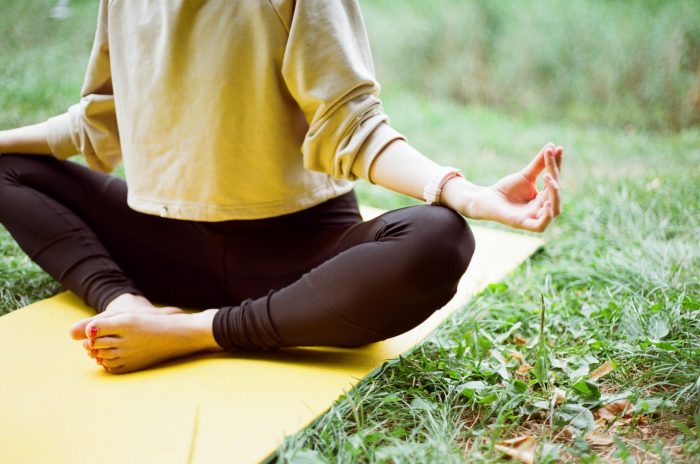No, you should not push through the pain.
If we are interested in our body and mind’s health, and aging gracefully, we must take an honest look at our yoga practice and fitness regimen. I differentiate between the two because yoga can be considered exercise as an entry point for the Western mind, but that is only the most basic of its possibilities.
A true yoga practice is not interchangeable with other types of fitness. I say “true” because many fad types of “yoga” are simply forms of physical exercise and a nice marketing ploy to appeal to students. This isn’t negative, it just isn’t yoga.
Eva Panigrahi, who has her master’s in counseling psychology and is currently in a doctoral program in clinical psychology with an interest in obesity/bariatrics, says, “I think our culture has Westernized the practice of yoga and consequently, yoga is viewed as an ‘exercise’ (e.g., hot yoga) and less as a fusion of the physical, mental, and spiritual practices, which to me is the true eternal essence of yoga.”
Patanjali gave classical yoga its form under his Eight-Limbed Path. The thing of interest here is that asana, or physical posture, was allowed to be undertaken only after the first two limbs—outward conduct called the yamas and the rules for inner conduct called the niyamas—were perfected. The first limb of the yamas includes non-harm, or ahimsa, as its first rule, followed later by non-attachment, or aparigraha. Both of these are important litmus tests for a mindful approach to physical practices.
Another item of note is that postures we recognize in yoga today are arguably only 100 to 150 years old, influenced heavily by the British craze of calisthenics and acrobatics. There are rumors that the British actually shamed yoga practitioners in India for being weak and then added these Western techniques.
This yoga amalgamation was introduced to a Western audience by Pattabhi Jois, a student of Krishnamacharya, and founder of Ashtanga (meaning Eight-Limbed) Yoga. While the practice coming out of this tradition is beautiful and effective, we must assess if we are addicted to a certain style of yoga, or of any form of exercise.
Panigrahi says that, “Exercise addiction is not an official diagnostic disorder, but could be labeled under a type of behavioral addiction.” She would categorize an individual to have a behavioral addiction (e.g., exercise addiction) “when the behavior is impulsive, compulsive, and it interferes and/or causes dysfunction in the individual’s life.” This is important because dysfunction refers not only to the mental but physical “malfunctions,” such as repetitive stress injuries.
We are encouraged to push through the pain in yoga and fitness maybe to prove to ourselves we have military-like discipline, or maybe to show we are tough and can keep up. This might be a product of an archaic part of the nervous system that remembers being culled from the pack if one was too slow or infirm. Whatever the case, we are doing considerable harm to ourselves by not recognizing the damage we might be doing.
Non-harm or ahimsa, is the first tenet in the Eight-Limbed path.
As a yoga therapist, I work with unwinding long-held patterns. We all have them, whether in the form of a shift in our hips to the unexamined belief that we have to workout hard. The problem is introduced with repetitive stress injuries that inevitably come with unmindful exercise and posture and unhealthy mental habits.
In fact, these types of injuries can be a powerful marker for reassessing our physical activities and our own postural biases. Take the example of Warrior II: practicing this pose without knowing proper alignment and, more importantly, your own body’s biases and patterns will eventually result in an injury, either from too much twisting at the knee joint, or osteoarthritis of the hip because of stretched ligaments.
Chronic pain is not a marker of toughness but an indication from our intelligent bodies that we are not correctly aligned, and/or not adjusting to, or knowing, our own compensation patterns. Pushing through joint pain, or chronic pain in certain activities or postures will lead to greater and more serious injuries in the future. Muscular soreness is not the same thing and, in this way, we must also be cognizant about learning the difference between dangerous pain that is alerting us to something, or simply sensation. If we have an impulse to push into the pain, or ignore it, we can work up the courage to ask why.
Panigrahi says that, “For an individual with an exercise addiction, he or she would have to engage in exercise activities more frequently to endure the euphoric feeling and, in this way, build a tolerance.” When we exercise, chemicals like endorphins and dopamine are released and are similar to drug addiction.
Panigrahi also says that, “Possible underlying psychological factors (e.g., body image, body dysmorphia, and low self-esteem) may attribute to individuals engaging in excessive exercise regimens.” She goes on to list signs to be on the look out for with these few questions:
Do you feel like exercise dominates your life?
Will you feel guilty for the day if you’re not able to exercise?
Do you have chronic overuse injuries from exercising?
Do you feel a loss of control if you are unable to exercise for a day?
Exercise addiction is socially and culturally acceptable and even encouraged, but will most likely cause an enormous physical breakdown when continued. Somewhere along the way, Western society picked up the belief that the harder we exercise, the better. Maybe it is a mutation of the Protestant work ethic, but this belief must be examined as well. Panigrahi says, “Although the exercise craze comes with good intention, our culture seems to view exercise as the primary weight-loss tool, forgetting that diet and living a healthy lifestyle are equally or probably more important.”
If we are committed to a life of healing, we must look at this even more deeply using the tool of aparigraha, or non-attachment. The impermeability of life is a guide for our practice. Nothing stays the same, and as we learn, grow, and are willing to release, we change and can come to enjoy the other benefits that yoga has to offer. If we found a style that helped heal us, we can have a tendency to become attached to that style instead of seeing it as a tool of healing for that time.
There is a Zen koan that says, “If you meet Buddha on the road, kill him.” Buddha, in this instance for me, represents an unwavering idea of a proverbial buddha-ness, causing blindness to the possibility of seeing a truer buddha nature—our own. I think this is useful because we become so addicted to our unexamined beliefs, ideas, and opinions that we hold on to these attachments stubbornly and blindly causing so much harm and pain as a result. We can make a commitment in this one aspect to see how our attachments to physical exercise and yoga may be creating damage and an unhealthy body and mind.
This issue is complex and individualized, but we can begin to empower ourselves and run our physical activity through the filters of non-attachment and non-harm instead of being driven by our habits. In this way, we can remain active as we age instead of being incapacitated through injury.
We can also begin to unwind the deeper habits of our minds and unexamined beliefs that drive us to cause ourselves eventual harm through unmindful exercise and yoga habits.
~
~
~
Editor: Travis May
Copy Editor: Nicole Cameron
Social Editor: Callie Rushton











Read 0 comments and reply